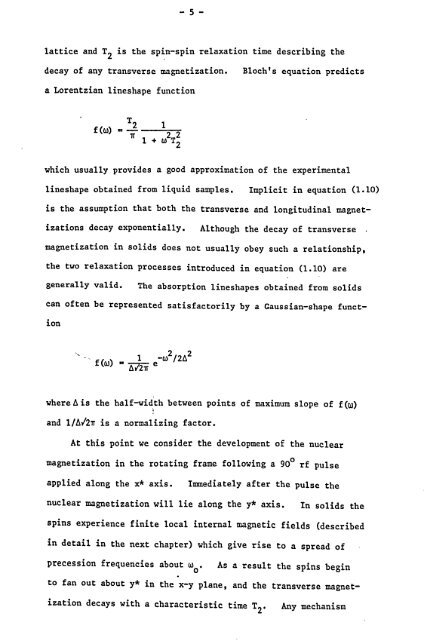NNR IN RAPIDLY ROTATED METALS By - Nottingham eTheses ...
NNR IN RAPIDLY ROTATED METALS By - Nottingham eTheses ...
NNR IN RAPIDLY ROTATED METALS By - Nottingham eTheses ...
Create successful ePaper yourself
Turn your PDF publications into a flip-book with our unique Google optimized e-Paper software.
-5-<br />
lattice and T2 is the spin-spin relaxation time describing the<br />
decay of any transverse magnetization. Bloch's equation predicts<br />
a Lorentzian lineshape function<br />
f (c)) aT21 1+ w2 T2<br />
which usually provides a good approximation of the experimental<br />
lineshape obtained from liquid samples. Implicit in equation (1.10)<br />
is the assumption that both the transverse and longitudinal magnet-<br />
izations decay exponentially. Although the decay of transverse<br />
magnetization in solids does not usually obey such a relationship,<br />
the two relaxation processes introduced in equation (1.10) are<br />
generally valid. The absorption lineshapes obtained from solids<br />
can often be represented satisfactorily by a Gaussian-shape funct-<br />
ion<br />
fýý)<br />
1e W2/2A2<br />
. 2. i<br />
where A is the half-width between points of maximum slope of f(W)<br />
and 1/02ir is a normalizing factor.<br />
At this point we consider the development of the nuclear<br />
magnetization in the rotating frame following a 900 rf pulse<br />
applied along the x* axis. Immediately after the pulse the<br />
nuclear magnetization will lie along the y* axis. In solids the<br />
spins experience finite local internal magnetic fields (described<br />
in detail in the next chapter) which give rise to a spread of -<br />
precession frequencies about wo As a result the spins begin<br />
to fan out about y* in thex-y plane, and the transverse magnet-<br />
ization decays with a characteristic time T2. Any mechanism

















